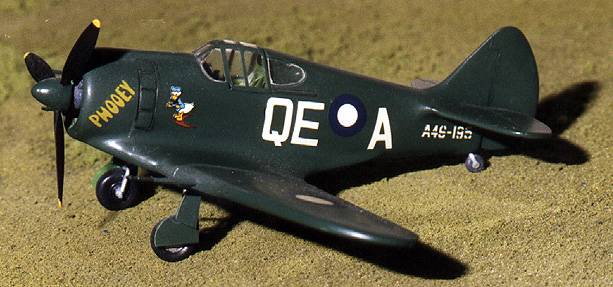 Comments: The Boomerang was Australia's only indigenous fighter of WWII. Rapidly designed using as many parts as possible from the Wirraway army co-operation aircraft (itself designed from the Harvard trainer), it proved itself to be an easy to maintain, robust aircraft that was mostly used for ground support. In fact, this fighter never shot down a single Japanese aircraft!
Comments: The Boomerang was Australia's only indigenous fighter of WWII. Rapidly designed using as many parts as possible from the Wirraway army co-operation aircraft (itself designed from the Harvard trainer), it proved itself to be an easy to maintain, robust aircraft that was mostly used for ground support. In fact, this fighter never shot down a single Japanese aircraft!
This kit has always been extremely popular and when Airfix had not re-released
the kit for a number of years, it commanded a rather high price in the kit collector's world. I had bought several of them in blister packs back in the mid 1970s so built this one up about ten years ago when they were still rare. The kit I had was defective in that the rudder on one fuselage half was short-shot. A typical Airfix kit of the time, it was festooned with golf ball size rivets, so the first thing I did was to sand all of them off. The next thing was to replace all the kit gear doors with plastic card. I also got a white metal engine to replace the rather poor representation offered by the kit. Finally, I scratch built a more representative interior, as the one offered by the kit is just a seat and a floor. I did not go to any great lengths for interior authenticity as the kit supplied canopy is quite distorted, but clear enough to see through.
On to construction. This is really quite a simple kit comprising less than 30 total parts. There were three major areas of concern. First was the wing to fuselage join. This area required a great deal of attention and putty. It took several applications to get a decent transition. Secondly was the air intake on the top of the engine cowling. This required great amounts of putty and patience to get to look good as the kit parts did not fit at all well. The third area was one that I made myself. I wanted a nice white metal engine to replace the one in the kit. I used an Aeroclub P&W 1830 Twin Wasp as on the real aircraft. The problem was that the engine was way too big for the kit. Even with much grinding of the inside of the fuselage and cowling, it was apparent that it would not fit. My only recourse, other than to forget the whole thing, was to decrease the circumference of the engine. I placed it in a moto tool and started grinding it down. I basically got it to fit after I had ground down below the valve covers! It does look very nice in the completed kit, but if I had it to do over again, I would think three times. The rest of the kit went without a hitch and the usual amount of putty.
When it came for camouflage time, I decided on an easy scheme of overall foliage green. I used FS 34092 in the Gunze range and it looks quite nice. Since the kit decals were yellowed and brittle beyond use, I took a scheme from an old ESCI sheet that I had. This showed an aircraft named 'Phooey' with a Donald Duck cartoon. After the kit was overcoated with Future, the decals were applied and worked very well indeed. A final coat of flat, proper staining and the kit was complete.
Since this build, the kit has been re-released as a series two for $6.00 and is quite unchanged from its original release. For
those wanting a new kit, Special Hobby has come to your rescue. Saying that, I
still recommend this kit as it can be an easy build. You do need to keep in mind its vintage and take that into consideration.
November 1996
Copyright ModelingMadness.com. All rights reserved.
Back to Main Page
Back to Reviews Page
2020
 Comments: The Boomerang was Australia's only indigenous fighter of WWII. Rapidly designed using as many parts as possible from the Wirraway army co-operation aircraft (itself designed from the Harvard trainer), it proved itself to be an easy to maintain, robust aircraft that was mostly used for ground support. In fact, this fighter never shot down a single Japanese aircraft!
Comments: The Boomerang was Australia's only indigenous fighter of WWII. Rapidly designed using as many parts as possible from the Wirraway army co-operation aircraft (itself designed from the Harvard trainer), it proved itself to be an easy to maintain, robust aircraft that was mostly used for ground support. In fact, this fighter never shot down a single Japanese aircraft!